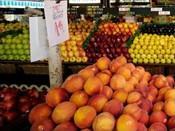Learn how to decipher produce stickers
United States
Wednesday 25 November 2009
Little produce stickers can provide valuable information
You'll find them on peppers, apples, melons and bananas. Those little produce stickers can be a nuisance, but they can provide valuable information if you know how to crack the code.
They are called PLU, or price look-up stickers, and they were designed to help busy cashiers figure out what's in your basket. Produce industry consultant Jack Kupp said the numbers can help cashiers distinguish between a Gala apple and a Fuji apple, which look very similar.
Each piece of produce has a four or five digit code. "It's amazing what you can learn from those if you know the codes," Kupp said.
A four digit number means it's conventionally grown, most likely with pesticides and fertilizers. A five digit number starting with 9 indicates the produce is organically grown. A five digit number starting with an 8 means it's been genetically modified.
There are also stickers that have computer data bars. Those codes can help the supermarket trace where the food was grown, information that could come in handy in a recall.
But now a new startup is providing that information directly to consumers. Right now, one can find it on strawberries and watermelons. Consumers can enter the code on the Harvest Mark website and learn where the piece of produce was grown, when it was harvested, if it's organic and what the company calls the food safety status. The company is expanding; some large grocery chains are also using Harvest Mark on salad greens.
And just in case you do bite into an apple with the sticker still on, there's no need to worry -- the stickers are edible!





